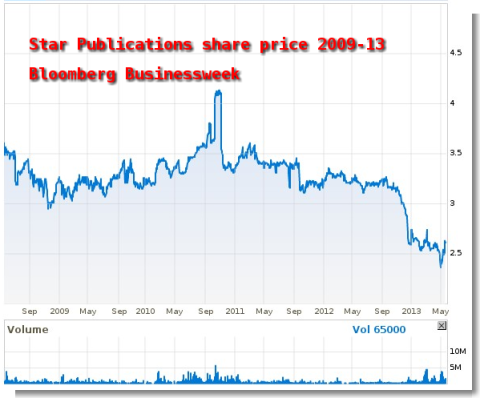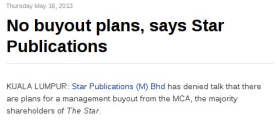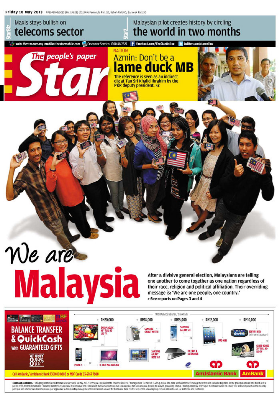Malaysia Today - Your Source of Independent News |
| Will a sellout help the fading Star? Posted: 21 May 2013 02:13 PM PDT Questions of credibility and crumbling sales Although MCA president Chua Soi Lek has firmly denied speculation of the party selling off its assets, among which The Star is a prize item, for its political and financial power, it is still an open question as to whether the MCA's ownership of the paper is becoming a drag on the paper and its commercial success. [No sale] Raja Petra Kamarudin at Malaysia Today had speculated yesterday that the MCA would suffer the fate of Umno after its deregistration and rebirth as Umno Baru in 1989, and become subject to asset-stripping by its taikos. RPK had named the Star's chairman, Fong Chan Onn, executive deputy chairman Vincent Lee as among those most likely to lead any such shuffling of MCA assets. [RPK] Speculation about a possible sale of MCA holdings in property and investments (the MCA building in Jalan Ampang, Menara Multi-Purpose in Capital Square and others) arose after the party's drubbing at the general election on May 5. Only seven of its candidates were returned as MPs, and 11 as state assemblymen in its worst electoral performance. Soon there was further talk of giving up the ghost and liquidating the party's assets. The Star is a prize asset, together with its minor publications and three radio stations. The party's 42% stake in Star Publications, the publishing company, bring in tens of millions of ringgit in annual dividends. There is also the prospect of making capital gains — but any fire-sale of the investment in the Star would result in a massive loss. The MCA paid RM1.2bln to take over the Star stake from Huaran Holdings, the party's investment arm. At its current trading price of RM2.60, the party's 313mil shares have a market value of just over RM813mil — RM400mil less than it paid for the stake. The rumours begin
A dud: MCA attack strategy
Vincent's agencies blamed More fearmongering More criticism
More hypocrisy
That decline in value is also reflected in the Star's loss of credibility among the politically aware, robbing the the MCA of any advantage it might have had from the Star's reach into the hearts and minds of the Malaysian Chinese electorate, and Malaysian society as a whole, The market has shifted. The Star's core readership of middle-class Malaysians in urban centres turned its back on the Barisan Nasional and the MCA at the general election, and there is increasing criticism of the paper's sycophantic coverage of the MCA. There is generally lacklustre coverage of opposition politics (but even that is criticised by pro-Umno bloggers and brings rebukes from Barisan Nasional flunkies at the PM's Department). The Star is thus caught at a crossroads, damned if they do and damned if they don't. Coverage of opposition politics, especially of the DAP, brings swift complaints from MCA and Umno politicians. Critical coverage of opposition politicians brings swift condemnation from readers and calls for a boycott. In the Star newsroom, as well as newsrooms elsewhere, are a large number of journalists who would be personally predisposed towards the opposition, for much the same reasons the urban middle-class rejected the Barisan Nasional at the elections: out of sympathy for the underdog, out of disgust with the oppressive and over-the-top racialism of Barisan Nasional politics, as well as professional disgust at having to give a professional gloss at propaganda. (However any disgust at giving a professional gloss to the commercial propaganda that fills most of the other pages is mitigated by an innate sense of survival.) Read more at: http://uppercaise.wordpress.com/2013/05/22/the-star-sellout-mca/
|
| Sistem ‘pecah dan perintah’ yang hampir-hampir terkubur Posted: 21 May 2013 12:58 PM PDT 'Tsunami Cina' dan tindak balas susulan Kemerosotan sokongan masyarakat Cina kepada Barisan Nasional (BN) pada PRU-13 amatlah ketara. Di bandar-bandar besar, sokongan mereka merosot serendah 10%. Akibatnya, walaupun berjaya mengekalkan kuasa di peringkat pusat, prestasi BN kali ini lebih teruk dari prestasi terburuknya sebelum ini (2008). Jika pencapaian buruk PRU-12 dijelaskan dengan 'tsunami politik', kemerosotan pencapaian BN PRU-13 dikaitkan dengan 'tsunami Cina'. Biarpun ungkapan 'tsunami Cina' benar dari segi statistik, olahan media perdana bersifat reaktif dan emosional. Ungkapan tersebut diolah bagi meluahkan rasa kecewa kepimpinan BN terhadap kaum Cina. Artikel-artikel akhbar seperti , 'Apa lagi Cina mahu?', dan komentari-komentari PRU-13 di television – semuanya menuding jari kepada kaum Cina, seolah-olah kaum cina adalah punca kemerosotan sokongan rakyat kepada BN Selaku kerajaan, tindakan menyalahkan segmen masyarakat yang tidak memberikan kemenangan yang diingini, menonjolkan ketidak-matangan kepimpinan (apatah lagi jika disusuli dengan penindasan seperti yang dilakukan kepada rakyat Kelantan selama ini). Ia juga menyerlahkan hipokrasi slogan 1Malaysia. Adakah polisi 'segalanya' 1Malaysia itu hanya untuk meraih undi? Dan, tidakkah ia hipokrit apabila undi yang diraih tidak '1Malaysia', semangat 1Malaysia yang dilaung-laungkan hilang entah ke mana? Pengolahan ungkapan 'tsunami Cina' juga bersifat provokatif. Ia membakar sentimen perkauman; menakut-nakutkan masyarakat Cina dan menaikkan kemarahan masyarakat Melayu. Bukankah ini tindakan provokasi yang mengancam ketenteraman awam? Bukankah kerajaan BN dahulu yang memberi jaminan keamaan semasa dan selepas proses pilihanraya? Pelik jika diteliti perilaku pemimpin-pemimpun BN. Sikap mereka dilihat sama-sekali tidak konsisten, sebelum dan selepas PRU. Puncanya – tidak lain, tidak bukan, hanyalah kerana sistem 'pecah dan perintah' tinggalan penjajah yang diwarisi dan diguna pakai kerajaan selama ini, hampir-hampir digagalkan pada PRU-13. Persepsi salah mengenai aktivisme Cina Penulis berpeluang berkerjasama dengan aktivis-aktivis Cina sepanjang tempoh kempen PRU-13. Apa yang penulis saksikan, pergerakan aktivisme Cina ini cukup berbeza dari persepsi orang Melayu terhadap mereka. Dari sudut demografi, aktivis-aktivis Cina ini adalah dari golongan pertengahan dan majoritinya dari golongan muda. Mereka terdiri dari pemilik perniagaan kecil seperti pengusaha kedai komputer dan butik pakaian, dan juga mahasiswa. Mereka adalah golongan majoriti Cina yang rata-rata berfikiran sederhana dan tradisional. Mereka bertutur dalam bahasa Cina sesama sendiri, tetapi memilih untuk menggunakan bahasa Melayu apabila bergaul dengan orang Melayu. Mereka bukanlah tauke-tauke kapitalis yang licik menipu orang Melayu. Perlakuan dan karakter mereka tidak ubah seperti mana-mana kelas pertengahan; tidak kiralah orang Melayu, atau orang putih, mahupun orang Afrika – 'simple-minded', rajin bekerja dan suka berjenaka. Walaupun penguasaan bahasa Melayu mereka ditahap memalukan (selaku rakyat Malaysia), usaha bertutur dalam bahasa Melayu, lebih-lebih lagi golongan muda, boleh diberi pujian. Read more at: http://secebiswaras.wordpress.com/2013/05/09/sistem-pecah-dan-perintah-yang-hampir-hampir-terkubur/ |
| You are subscribed to email updates from Malaysia Today - Your Source of Independent News To stop receiving these emails, you may unsubscribe now. | Email delivery powered by Google |
| Google Inc., 20 West Kinzie, Chicago IL USA 60610 | |

 Malaysia Today - Your Source of Independent News
Malaysia Today - Your Source of Independent News







0 ulasan:
Catat Ulasan